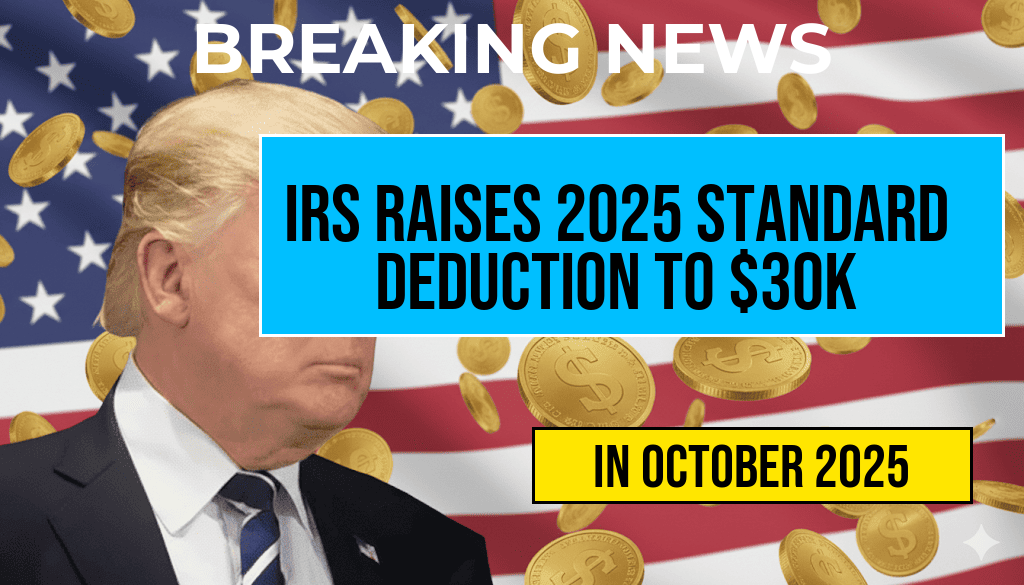The Internal Revenue Service (IRS) announced a significant update to the standard deduction for the 2025 tax year, increasing it by $800 for married couples filing jointly. This adjustment raises the total standard deduction to $30,000, marking a notable increase from the previous year. As inflation continues to influence the economy, this increase aims to provide relief to taxpayers by reducing taxable income. The change is part of the IRS’s annual adjustments to account for inflation, ensuring that the standard deduction maintains its purchasing power and continues to serve as a vital tool for simplifying tax filing. Taxpayers should prepare for these modifications, which could impact their overall tax liability, especially those who itemize deductions or rely heavily on the standard deduction to minimize their taxable income. The new figures will take effect for returns filed in 2026, covering the 2025 tax season.
Details of the 2025 Standard Deduction Increase
What the Change Means
| Filing Status | 2024 Deduction | 2025 Deduction | Increase |
|---|---|---|---|
| Married Filing Jointly | $29,200 | $30,000 | $800 |
| Single | $14,600 | $15,000 | $400 |
| Head of Household | $22,300 | $23,000 | $700 |
The increase for married couples filing jointly aligns with inflation adjustments, ensuring the deduction remains a key component of the tax code’s efforts to provide financial relief. The marginal increases for single filers and those filing as head of household reflect similar inflation-related adjustments, maintaining consistency across filing statuses.
Context and Implications for Taxpayers
Why the Adjustment Matters
Adjustments to the standard deduction are a routine part of IRS updates, designed to prevent inflation from eroding the benefit that taxpayers derive from this simplified deduction method. For many filers, the standard deduction reduces taxable income, decreasing overall tax liability and streamlining the filing process. As the deduction grows, individuals and families may find it easier to offset income without the need for itemized deductions, which often require extensive documentation.
For taxpayers who typically claim the standard deduction, this increase could translate into tangible savings on their annual tax bills. Conversely, those who itemize deductions—such as mortgage interest, charitable contributions, and medical expenses—may experience less immediate impact but can benefit indirectly from the broader inflation adjustments to other tax parameters.
Impact on Tax Planning and Filing
- Tax Bracket Adjustments: The increased standard deduction may push some taxpayers into lower brackets, reducing their tax rate.
- Tax Software Updates: Tax preparation software will incorporate these new figures, ensuring accurate calculations for the upcoming filing season.
- IRS Guidance: The IRS provides comprehensive instructions and calculators on its official website to assist taxpayers in understanding how these changes affect their filings. Visit irs.gov for updates.
Broader Economic Context
Inflation and Tax Policy
The IRS’s inflation adjustments reflect ongoing economic conditions that influence the cost of living. The increase in the standard deduction is part of a broader effort to preserve the tax system’s fairness, ensuring that inflation doesn’t disproportionately increase tax burdens. This approach aligns with the federal government’s broader fiscal policy goals, which include supporting middle-income families and maintaining equitable tax structures.
According to economic analyses, maintaining inflation-adjusted deductions helps prevent tax brackets and deductions from becoming outdated, which could otherwise lead to increased tax liabilities for average Americans. For more detailed insights into inflation’s impact on tax policy, visit Wikipedia’s page on inflation in the United States.
What’s Next for Taxpayers and Tax Professionals
Preparing for the 2025 Tax Filing Season
Tax professionals and filers should review the updated deduction amounts when preparing returns for the 2025 tax year. Ensuring accurate application of these figures can optimize tax savings and compliance. Additionally, taxpayers should stay informed about other inflation-adjusted figures, such as contribution limits for retirement accounts and estate tax thresholds, which may also see changes.
The IRS typically releases comprehensive guidance in the fall, allowing taxpayers and preparers ample time to incorporate new figures into their planning. Staying connected with official resources and consulting qualified tax advisors can help navigate the complexities of the evolving tax landscape.
Frequently Asked Questions
What is the new standard deduction amount for couples in 2025?
The standard deduction for couples in 2025 has increased by $800, bringing the total to $30,000.
Why did the IRS increase the standard deduction for 2025?
The IRS adjusts the standard deduction annually to account for inflation, ensuring that taxpayers can benefit from higher deductions to reduce their taxable income.
How does the increase in the standard deduction affect taxpayers?
The increase allows couples to reduce their taxable income more significantly, potentially lowering their overall tax liability and simplifying their tax filing process.
Will the standard deduction amount change for other filing statuses in 2025?
While this article focuses on couples, the IRS typically adjusts the standard deduction for all filing statuses annually. You should check the IRS guidelines for specific amounts for singles, heads of household, and other statuses for 2025.
When will the new standard deduction amounts take effect?
The increased standard deduction will be applicable for the 2025 tax year, meaning it will be used when filing taxes in early 2026.






